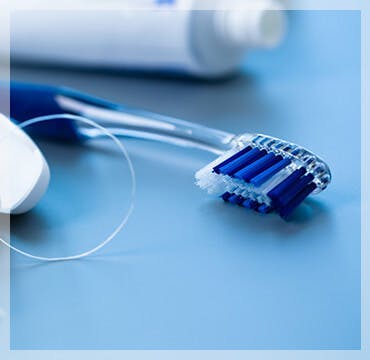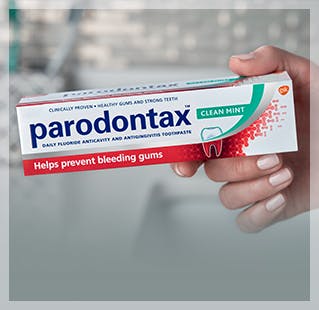
Why Is Flossing and Interdental Cleaning Important?
It’s easy to forget your dental hygiene after a long day or when you’re rushing out the door in the morning. However, taking care of your teeth and gums should be a priority, including flossing every day. Removing plaque bacteria is one of the best ways to help protect against early gum disease; however, it’s difficult to reach the spaces between your teeth by brushing alone.1 Dental floss and other interdental aids can help to remove plaque buildup between your teeth and slightly below the gum line (where your tooth meets the gum) and can also help stop bleeding gums when done once per day or as recommended by your dental professional.1
The Benefits of Flossing and Interdental Cleaning
Cleaning between your teeth at least once daily can help prevent oral health problems like cavities or gum disease.2 By removing plaque from between your teeth and slightly below your gum line, flossing plays an important role in helping to maintain your overall health.2 Bacteria from plaque release acid eats away at your tooth enamel, which can lead to tooth decay.2 Plaque that is not routinely removed can eventually harden into tartar, which can only be removed by your dental professional.2 If left untreated, built-up tartar can lead to gingivitis, which is where interdental cleaning can help remove plaque bacteria and prevent it from becoming tartar.2
Gingivitis, the early stage of gum disease, may cause your gums to bleed and become red and swollen.3 At this stage, gingivitis is reversible with daily home care oral hygiene that includes flossing at least once daily.3 Flossing helps gums by cleaning hidden spaces between your teeth, which can prevent irritation and inflammation as well as helping to prevent other oral health problems.2
Advanced gum disease, also known as periodontitis, is a major contributor to tooth loss and may become severe over time.3 If your gums are bleeding when you floss, you may be experiencing periodontal disease, where bacteria, tartar and plaque can build up along your gums.2 Contact your dental professional for an appointment if this happens.
Maintaining good oral hygiene can protect your teeth and gum from common dental issues. Some studies and ongoing research also indicate that advanced gum disease may be associated with health conditions like heart disease.4 At this time, it is very important to contact your dental professional and schedule a visit.
Flossing Tips
When it comes to flossing teeth effectively, it’s important to use the right technique. Here’s a simple guide to help show you how to floss properly:5

Always be gentle. If you floss too aggressively, you could damage your gums.

Break off around 18 inches of floss and wind the ends around one finger of each hand.

Hold the floss gently between your thumbs and forefingers, with around 1 inch held taut between them.

Use a gentle rocking motion to insert the floss between your teeth.

When the floss reaches the gum line, curve it into a C-shape against the tooth.

When the floss reaches the gum line, curve it into a C-shape against the tooth.

When the floss reaches the gum line, curve it into a C-shape against the tooth.
If you see blood after you’ve been flossing for a few days, it could be a sign that you have gum disease and should see your dentist as soon as possible.3
How Often Should You Floss?
From the age of 12 on, you should use interdental brushes or floss to clean between your teeth once a day before brushing.2 Floss thoroughly when you wake up in the morning, before you go to bed, or any time of day you can devote a few minutes to cleaning your teeth.2 The time of day you choose to floss won’t impact its effects, including whether you floss before or after you brush your teeth.2
Flossing Tips
When it comes to flossing effectively, it’s important to use the right technique. Here’s a simple guide to help show you how to floss properly:2

Always be gentle. Some signs of over-flossing include pain in your gums and damage to the tissue between your teeth.

Break off around 18 inches of floss and wind the ends around one finger of each hand.

Hold the floss gently between your thumbs and forefingers.

Use a gentle rubbing motion to insert the floss between your teeth.

When the floss reaches the gum line, curve it into a C-shape against the tooth.

Hold the floss against the side of the tooth and gently scrape away from the gum.

Keep to a regular rhythm to ensure you don’t miss any teeth. Don’t forget the back of your last tooth.
How Often Should You Floss?
You should use interdental brushes or floss to clean between your teeth once a day before brushing, as per the instructions of your dental professional.2 Floss thoroughly when you wake up in the morning, before you go to bed, or any time of day you can devote a few minutes to cleaning your teeth.2 The time of day you choose to floss won’t impact its effects, including whether you floss before or after you brush your teeth.2
How to Maintain Good Oral Hygiene
Flossing every day should be one important step in your overall oral hygiene routine, but your regimen shouldn’t stop there. To keep your mouth healthy, follow these dental hygiene tips:1
- Brush your teeth twice daily with a fluoride toothpaste that’s designed to reverse signs of early gum disease like parodontax Active Gum Repair Whitening Toothpaste.
- Floss between your teeth at least once a day.
- Try a toothbrush with a compact head, like the parodontax Complete Protection Toothbrush, to help clean hard-to-reach areas.
- Eat a healthy, balanced diet.
- If you’re able, regularly see your dental professional for cleanings and check-ups.
- Try an antiplaque oral rinse to help kill plaque bacteria associated with gingivitis.*
By flossing at least once a day you can help prevent oral health problems like gum disease and cavities.1,2 To learn more about maintaining healthy gums, explore more helpful articles from parodontax.
*kills plaque bacteria associated with gingivitis and odor causing bacteria in laboratory tests
Source Citations:
- Floss/interdental cleaners. American Dental Association. https://www.ada.org/resources/research/science-and-research-institute/oral-health-topics/floss/. Accessed 6/13/22.
- Flossing. MouthHealthy. https://www.mouthhealthy.org/all-topics-a-z/flossing/.Accessed 6/13/22.
- Gum disease. MouthHealthy. https://www.mouthhealthy.org/en/az-topics/g/gum-disease/. Accessed 6/13/22.
- Heart disease and oral health. MouthHealthy. https://www.mouthhealthy.org/en/az-topics/h/heart-disease-and-oral-health/. Accessed 6/13/22.





